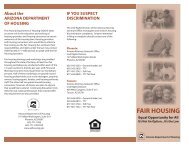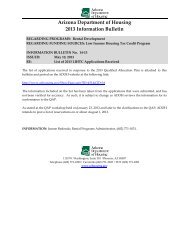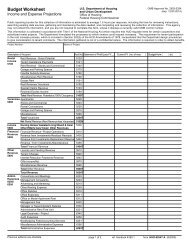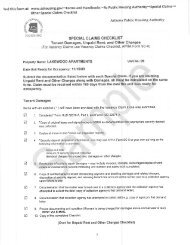2009 Arizona's Housing Market ...a glance. - Arizona Department of ...
2009 Arizona's Housing Market ...a glance. - Arizona Department of ...
2009 Arizona's Housing Market ...a glance. - Arizona Department of ...
Create successful ePaper yourself
Turn your PDF publications into a flip-book with our unique Google optimized e-Paper software.
<strong>2009</strong><br />
<strong>Arizona</strong>’s <strong>Housing</strong> <strong>Market</strong> ...a <strong>glance</strong>.<br />
The current recession which was originally triggered by troubles in the housing and financial markets has also<br />
dragged down the rest <strong>of</strong> the economy into recession. How long the recession will last is not clear, but there<br />
are signs that improvements in the economy and housing market will become noticeable towards the end <strong>of</strong><br />
this year or by the first half <strong>of</strong> next year.<br />
Last year at this time economists were debating whether or not the national and <strong>Arizona</strong> economies were in a<br />
recession. This year we know that both economies are in the midst <strong>of</strong> a severe and broad-based recession. The<br />
national economy has been in recession since December 2007 and <strong>Arizona</strong>’s economy started contraction a<br />
few months prior to that in the third quarter <strong>of</strong> 2007.<br />
Although there are some encouraging signs that existing home sales in <strong>Arizona</strong> surpass that <strong>of</strong> last year’s at<br />
this time, new home construction and sales are still very weak and home loan approval standards are tight. In<br />
terms <strong>of</strong> home foreclosure rate, Florida, Nevada, California and <strong>Arizona</strong> have been on top <strong>of</strong> the list for most <strong>of</strong><br />
the 2008 and <strong>2009</strong>. Some projections show that <strong>Arizona</strong>’s foreclosure severity may noticeably ease up by the<br />
middle <strong>of</strong> 2010.<br />
As the housing and broader economic market follows their adjustment processes, many <strong>Arizona</strong> families are<br />
struggling to find and secure affordable housing as renters or homeowners. Affordable housing is generally<br />
described as standard and sanitary dwellings that cost no more than 30 percent <strong>of</strong> monthly household gross<br />
income. The U.S. Census Bureau’s 2007 American Community Survey data reveal that in <strong>Arizona</strong>, almost 46<br />
percent <strong>of</strong> all renters and more than 26 percent <strong>of</strong> homeowners spend more than 30 percent <strong>of</strong> their incomes<br />
on housing.<br />
The analyses and tables in this document are based on data available for early <strong>2009</strong> or for 2008 on housing,<br />
income, population, employment, and wages by occupation and by industry. To enable equitable comparison<br />
and consistency in this report, we have compared communities across the state on affordability reflected in<br />
the median home price or fair market rent in each area. Median price refers to the middle <strong>of</strong> the price range.<br />
The information compiled for this report also reveals that median home prices in <strong>Arizona</strong>’s rural communities<br />
range from a relatively low price <strong>of</strong> $69,000 in Parker to a high price <strong>of</strong> $417,000 in the Sedona area. The most<br />
expensive among all <strong>Arizona</strong> rural and urban communities is the Town <strong>of</strong> Paradise Valley, with a median home<br />
sales price <strong>of</strong> $1.3 million. In general, home prices are much higher in urban areas and in communities that<br />
attract large numbers <strong>of</strong> seasonal and recreational tourists.<br />
Comparing this year’s report on affordability with those <strong>of</strong> previous years, it is clear that median home sales<br />
prices have been falling in many communities and affordability has been improving. While lower prices can<br />
improve affordability, they can adversely impact many owners and potential sellers whom are watching their<br />
limited equity erode as prices decline to and even below existing debt level.<br />
The median housing price for existing homes at the state level and for most <strong>of</strong> the communities that are<br />
included in this study, reached their peak in either 2006 or in 2007. They have been following a declining path<br />
ever since. From 2007 to <strong>2009</strong>, the median price <strong>of</strong> existing homes decreased by eight percent at the state<br />
level and dropped by approximately 30 percent for all jurisdictions combined.<br />
1









